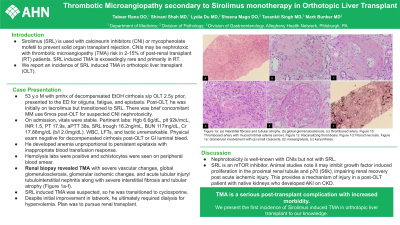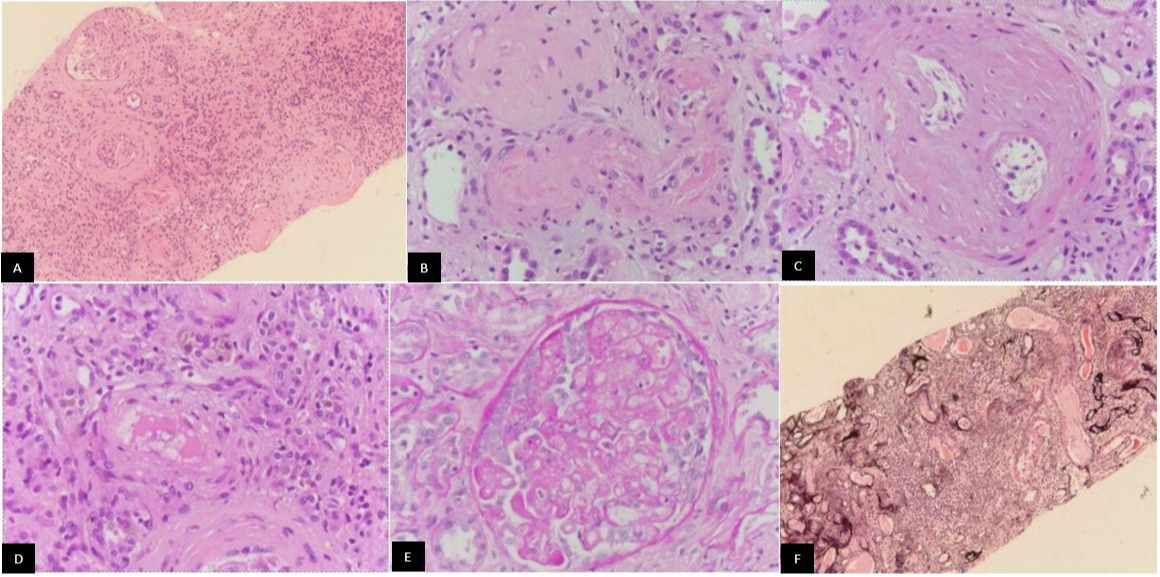Monday Poster Session
Category: Liver
P2587 - Thrombotic Microangiopathy Secondary to Sirolimus Monotherapy in Orthotopic Liver Transplant
Monday, October 23, 2023
10:30 AM - 4:15 PM PT
Location: Exhibit Hall

Has Audio
- TR
Tabeer Rana, DO
Allegheny Health Network
Pittsburgh, PA
Presenting Author(s)
Tabeer Rana, DO1, Shivani Shah, MD1, Lydia Du, MD2, Sheena Mago, DO2, Tavankit Singh, MD1, Mark Bunker, MD1
1Allegheny Health Network, Pittsburgh, PA; 2Allegheny General Hospital, Pittsburgh, PA
Introduction: Sirolimus (SRL) is used with calcineurin inhibitors (CNI) or mycophenolate mofetil (MM) to prevent solid organ transplant rejection. CNIs may be nephrotoxic with thrombotic microangiopathy (TMA) risk in 2-15% of post-renal transplant (RT) patients. SRL induced TMA is exceedingly rare and primarily in RT. To our knowledge, we report the first incidence of SRL induced TMA in orthotopic liver transplant (OLT).
Case Description/Methods: A 53 y.o M with pmhx of decompensated alcohol-induced cirrhosis who underwent OLT 2.5y prior, presented to the ED for oliguria, fatigue, and epistaxis. Post-OLT, he was initially on tacrolimus, a CNI, but transitioned to SRL. There was brief concomitant MM use 6mos post-OLT for suspected CNI nephrotoxicity.
On admission, vitals were stable. Labs noted Hgb 6.6g/dL, plt 92k/mcL, INR 1.5, PT 17.9s, aPTT 38s, SRL trough 16.2ng/mL, BUN 117mg/dL, Cr 17.88mg/dL (b/l 2.0mg/dL). WBC, LFTs, and lactic were unremarkable. Physical exam negative for decompensated cirrhosis post-OLT or GI luminal bleed. He had worsening anemia attributed but not proportional to persistent epistaxis with inappropriate response to blood transfusions. Workup noted LDH 1826U/L, haptoglobin < 10mg/dL, and schistocytes on peripheral blood smear, indicating hemolysis. Renal biopsy was pursued. Pathology revealed TMA with severe vascular changes, global glomerulosclerosis, glomerular ischemic changes, and acute tubular injury/ tubulointerstitial nephritis along with severe interstitial fibrosis and tubular atrophy (Figure 1a-f). Immunohistochemistry was negative for BK virus and myoglobinuria. SRL induced TMA was suspected. He was transitioned to cyclosporine with improving labs. Ultimately, dialysis was initiated for hypervolemia with plan for RT.
Discussion: SRL and CNIs or MMs are used to prevent solid organ transplant rejection. Nephrotoxicity is well-known with CNIs but not with SRL. To our knowledge, one prior case of SRL induced TMA, notably in a RT patient, exists, and we present the first known instance of SRL induced TMA in OLT specifically. SRL is an mTOR inhibitor. Animal studies note it may inhibit growth factor induced proliferation in the proximal renal tubule and p70 (S6k), impairing renal recovery post acute ischemic injury. This provides a mechanism of injury in a post-OLT patient with native kidneys who developed AKI on CKD. TMA is a serious post-transplant complication with increased morbidity. We contribute to the literature on the potential nephrotoxicity of SRL in OLT patients.

Disclosures:
Tabeer Rana, DO1, Shivani Shah, MD1, Lydia Du, MD2, Sheena Mago, DO2, Tavankit Singh, MD1, Mark Bunker, MD1. P2587 - Thrombotic Microangiopathy Secondary to Sirolimus Monotherapy in Orthotopic Liver Transplant, ACG 2023 Annual Scientific Meeting Abstracts. Vancouver, BC, Canada: American College of Gastroenterology.
1Allegheny Health Network, Pittsburgh, PA; 2Allegheny General Hospital, Pittsburgh, PA
Introduction: Sirolimus (SRL) is used with calcineurin inhibitors (CNI) or mycophenolate mofetil (MM) to prevent solid organ transplant rejection. CNIs may be nephrotoxic with thrombotic microangiopathy (TMA) risk in 2-15% of post-renal transplant (RT) patients. SRL induced TMA is exceedingly rare and primarily in RT. To our knowledge, we report the first incidence of SRL induced TMA in orthotopic liver transplant (OLT).
Case Description/Methods: A 53 y.o M with pmhx of decompensated alcohol-induced cirrhosis who underwent OLT 2.5y prior, presented to the ED for oliguria, fatigue, and epistaxis. Post-OLT, he was initially on tacrolimus, a CNI, but transitioned to SRL. There was brief concomitant MM use 6mos post-OLT for suspected CNI nephrotoxicity.
On admission, vitals were stable. Labs noted Hgb 6.6g/dL, plt 92k/mcL, INR 1.5, PT 17.9s, aPTT 38s, SRL trough 16.2ng/mL, BUN 117mg/dL, Cr 17.88mg/dL (b/l 2.0mg/dL). WBC, LFTs, and lactic were unremarkable. Physical exam negative for decompensated cirrhosis post-OLT or GI luminal bleed. He had worsening anemia attributed but not proportional to persistent epistaxis with inappropriate response to blood transfusions. Workup noted LDH 1826U/L, haptoglobin < 10mg/dL, and schistocytes on peripheral blood smear, indicating hemolysis. Renal biopsy was pursued. Pathology revealed TMA with severe vascular changes, global glomerulosclerosis, glomerular ischemic changes, and acute tubular injury/ tubulointerstitial nephritis along with severe interstitial fibrosis and tubular atrophy (Figure 1a-f). Immunohistochemistry was negative for BK virus and myoglobinuria. SRL induced TMA was suspected. He was transitioned to cyclosporine with improving labs. Ultimately, dialysis was initiated for hypervolemia with plan for RT.
Discussion: SRL and CNIs or MMs are used to prevent solid organ transplant rejection. Nephrotoxicity is well-known with CNIs but not with SRL. To our knowledge, one prior case of SRL induced TMA, notably in a RT patient, exists, and we present the first known instance of SRL induced TMA in OLT specifically. SRL is an mTOR inhibitor. Animal studies note it may inhibit growth factor induced proliferation in the proximal renal tubule and p70 (S6k), impairing renal recovery post acute ischemic injury. This provides a mechanism of injury in a post-OLT patient with native kidneys who developed AKI on CKD. TMA is a serious post-transplant complication with increased morbidity. We contribute to the literature on the potential nephrotoxicity of SRL in OLT patients.

Figure: Figure 1a: (a) Interstitial fibrosis and tubular atrophy, (b) global glomerulosclerosis, (c) thrombosed artery.
Figure 1b: Thrombosed artery with mucoid intimal edema (arrow).
Figure 1c: Recanalizing thrombosis.
Figure 1d: Fibroid necrosis.
Figure 1e: Glomerular involvement with (a) small crescents, (b) mesangiolysis, (c) karyorrhexis.
Figure 1b: Thrombosed artery with mucoid intimal edema (arrow).
Figure 1c: Recanalizing thrombosis.
Figure 1d: Fibroid necrosis.
Figure 1e: Glomerular involvement with (a) small crescents, (b) mesangiolysis, (c) karyorrhexis.
Disclosures:
Tabeer Rana indicated no relevant financial relationships.
Shivani Shah indicated no relevant financial relationships.
Lydia Du indicated no relevant financial relationships.
Sheena Mago indicated no relevant financial relationships.
Tavankit Singh indicated no relevant financial relationships.
Mark Bunker indicated no relevant financial relationships.
Tabeer Rana, DO1, Shivani Shah, MD1, Lydia Du, MD2, Sheena Mago, DO2, Tavankit Singh, MD1, Mark Bunker, MD1. P2587 - Thrombotic Microangiopathy Secondary to Sirolimus Monotherapy in Orthotopic Liver Transplant, ACG 2023 Annual Scientific Meeting Abstracts. Vancouver, BC, Canada: American College of Gastroenterology.
